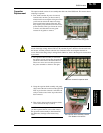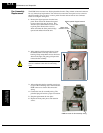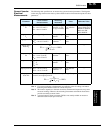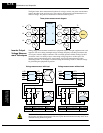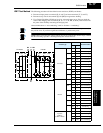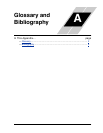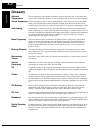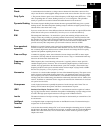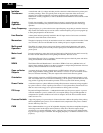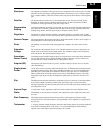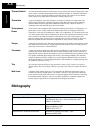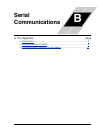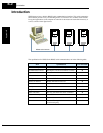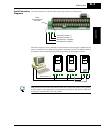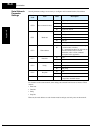
SJ300 Inverter
Appendix A
A–3
Diode A semiconductor device that has a voltage-current characteristic that allows current to flow
only in one direction, with negligible leakage current in the reverse direction. See also rectifier.
Duty Cycle 1. The percent of time a square wave of fixed frequency is ON (high) versus OFF (low). 2. The
ratio of operating time of a motor, braking resistor, etc. to its resting time. This parameter
usually is specified in association with the allowable thermal rise for the device.
Dynamic Braking The inverter dynamic braking feature shunts the motor-generated EMF energy into a special
braking resistor. The added dissipation (braking torque) is effective at higher speeds, having a
reduced effect as the motor nears a stop.
Error In process control, the error is the difference between the desired value or setpoint (SP) and the
actual value of a the process variable (PV). See also process variable and PID Loop.
EMI Electromagnetic Interference - In motor/drive systems, the switching of high currents and
voltages creates the possibility of generating radiated electrical noise that may interfere with
the operation of nearby sensitive electrical instruments or devices. Certain aspects of an instal-
lation, such as long motor lead wire lengths, tend to increase the chance of EMI. Hitachi
provides accessory filter components you can install to decrease the level of EMI.
Four-quadrant
operation
Referring to a graph of torque versus speed, a four-quadrant drive can turn the motor either
forward or reverse, as well as decelerate in either direction (see also reverse torque). A load that
has a relatively high inertia and must move in both directions and change directions rapidly
requires four-quadrant capability from its drive.
Free-run Stop A method of stopping a motor, caused when the inverter simply turns OFF its motor output
connections. This may allow the motor and load to coast to a stop, or a mechanical brake may
intervene and shorten the deceleration time.
Frequency
Setting
While frequency has a broad meaning in electronics, it typically refers to motor speed for
variable-frequency drives (inverters). This is because the output frequency of the inverter is
variable, and is proportional to the attained motor speed. For example, a motor with a base
frequency of 60 Hz can be speed controlled with an inverter output varying form 0 to 60 Hz.
See also base frequency, carrier frequency, and slip.
Harmonics A harmonic is a whole number multiple of a base of fundamental frequency. The square waves
used in inverters produce high-frequency harmonics, even though the main goal is to produce
lower-frequency sine waves. These harmonics can be harmful to electronics (including motor
windings) and cause radiated energy that interferes with nearby electronic devices. Chokes, line
reactors, and filters are sometimes used to suppress the transmission of harmonics in an electri-
cal system. See also choke.
Horsepower A unit of physical measure to quantify the amount of work done per unit of time. You can
directly convert between horsepower and Watts as measurements of power.
IGBT Insulated Gate Bipolar Transistor (IGBT) - A semiconductor transistor capable of conduct-
ing very large currents when in saturation and capable of withstanding very high voltages when
it is OFF. This high-power bipolar transistor is the type used in Hitachi inverters.
Inertia The natural resistance of an object to being accelerated or decelerated by an external force. See
also momentum.
Intelligent
Terminal
A configurable input or output logic function on the Hitachi inverters. Each terminal may be
assigned one of several functions.
Inverter A device that electronically changes DC to AC current through a alternating process of switch-
ing the input to the output, inverted and non-inverted. A variable speed drive such as the Hitachi
SJ300 is also called an inverter, since it contains three inverter circuits to generate 3-phase
output to the motor.



